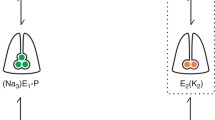Abstract
Ion-transporting ATPases (pumps) hydrolyze ATP to maintain ion gradients across cell membranes. A presupposition for the maintenance of the gradients is that the ionophore of the pump that conducts the ions is accessible only from one of the two surfaces of the plasma membrane at any given time. Thus, a characteristic feature of pumps is an occluded state of the transported ions, whereas ion channels upon stimulation remain open at both ends and allow ions to flow through them down their chemical gradients. Recent experiments, however, provide evidence that a channel, simultaneously open on both sides of the plasma membrane, can also be formed within the mammalian sodium pump (Na+,K+-ATPase) upon its interaction with the marine toxin palytoxin, thus underlining common structural features shared by channels and pumps. This assumption is further supported by the demonstration of structural and functional homology between the extracellular loop of the sodium pump α subunit connecting the M7 and M8 transmembrane spans and the P-loops of Na+ channels. Possibly, pumps are simply channels that are able to be gated by ATP and its product phosphate.
Similar content being viewed by others
Author information
Authors and Affiliations
Additional information
Received: 12 January 1998 / Accepted: 26 February 1998
Rights and permissions
About this article
Cite this article
Scheiner-Bobis, G. Ion-transporting ATPases as ion channels. Naunyn-Schmiedeberg's Arch Pharmacol 357, 477–482 (1998). https://doi.org/10.1007/PL00005196
Issue Date:
DOI: https://doi.org/10.1007/PL00005196




